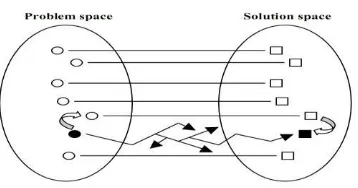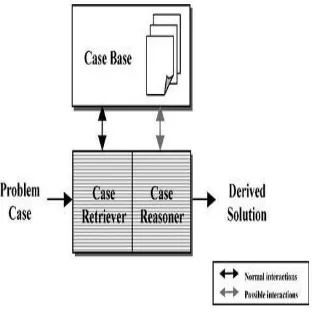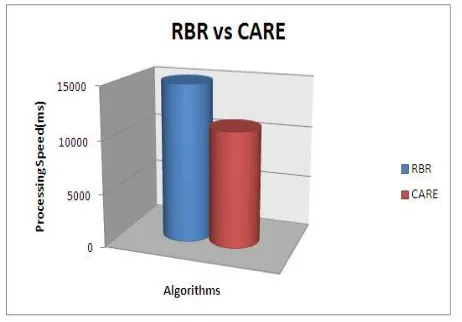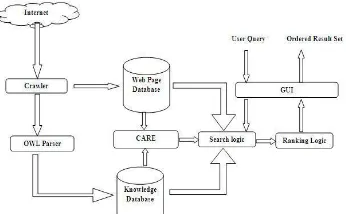Available Online at www.ijpret.com 982
INTERNATIONAL JOURNAL OF PURE AND
APPLIED RESEARCH IN ENGINEERING AND
TECHNOLOGY
A PATH FOR HORIZING YOUR INNOVATIVE WORK
COMPARISON OF CARE AND PIGEON ALGORITHM- A REVIEW
MISS. NEHA B. THAKARE1, PROF. R. R. SHELKE2
1.M.E. Second Year, CSE, HVPM COET, Amravati, India. 2.Prof. CSE Department, HVPM COET, Amravati, India.
Accepted Date: 05/03/2015; Published Date: 01/05/2015
Abstract: In today’sworld the role of web search engine is becoming more popular day by
day, Google the most famous search engine uses Page Ranking Algorithm. Ranking Algorithms arrange the results according to the user’s needs. Sometimes web engines produce very unsatisfactory results. If the pages are ranked according to the use’s preferences, then the result will be more accurate. The web page ranking algorithms play their role at the last component. Exactly what information the users want is unpredictable. So the web page ranking algorithms are designed to anticipate the user requirements from various static and dynamic features. They are important factors for making one search engine better than another. This paper focuses on the comparison of CARE and Pigeon Page rank algorithm.
Keywords: Algorithms, Dynamic, Anticipate, Page Ranking, CARE, Pigeon Page Ranking
Algorithm
Corresponding Author: MISS. NEHA B. THAKARE
Access Online On:
www.ijpret.com
How to Cite This Article:
Neha B. Thakare, IJPRET, 2015; Volume 3 (9): 982-991
S
Available Online at www.ijpret.com 983 INTRODUCTION
Today’s web is a human-readable Web [6] where information cannot be easily processed by machine. The Web contains a huge amount of data but computers alone cannot understand or make any decision with this data [2].In solution to this problem semantic web is introduced. It is the extension of the World Wide Web. It enables computer and people to work in co-operation.
WWW
Search
||
Engine
Content aggregators Content Consumers (Users)
Figure 1.Concept of a Search Engine
Page ranking is used by many web search engines to rank the websites. Important web sites are used to be ranked first according to the provided keywords. It assigns the numerical weighting to the web sites and calculates the score and computation time. As the time passes different types of algorithm are introduced to increase the efficiency of page rank algorithm [2-7]. Here we are going to focus on two algorithms and their comparison.
First one is the CARE algorithm and another is pigeon page rank algorithm. CARE [18-20] algorithm is case and relation based algorithm whereas Pigeon page rank algorithm is used for optimization purpose.
In order to rank the keywords requested by users more powerful and complex algorithms are required. CARE algorithm is one of them and it involves some concepts which can be illustrated as follows:
1. Case-Based Reasoning (CBR)
Available Online at www.ijpret.com 984
This concept is derived from a typical medical example in which the doctor examines the current symptoms of the patient and compares it with the patients who have been observed with the same symptoms in the past [2].
The quality of Case Based Reasoner’s [22] [23] solution depends upon the four things:
The past experiences.
Ability of understanding new cases from the experiences of the old cases.
Its skilful performance on adaptation.
Its skilful performance on evaluation.
Figure 2. Problem solving using CBR
Available Online at www.ijpret.com 985 Figure 3.Two major components of a CBR system
The role of the case retriever is to retrieve the appropriate case from the Case Base and Case Reasoner uses the retrieved cases for finding the solution of the given problem [8][9].
2. The CBR Cycle
CBR Cycle involves four phases.
• RETRIEVE: In this phase, the retrieval of the appropriate case takes place
• REUSE: This phase is related to the mapping of the solution from the previous case to the target problem.
REVISE: It proposes the solution.
RETAIN: Stores the results as a new case in the memory.
2. LITERATURE REVIEW
Available Online at www.ijpret.com 986
J. Kleinberg [5][6] gave us algorithm
“Hyperlink Induced Topic Search” (HITS). He recognized two different forms of web pages called hubs and authorities. Authorities are pages having important contents whereas Hubs are pages that act as resource lists guiding users to authorities. Thus a good hub page for a subject points to many authorities pages on that content, a good authority page is pointed by any good hub pages on the same subject.
Kleinberg [20-23] said that a page may be a good hub and good authority at the same time and this circular relationship lead to the definition of an iterative algorithm HITS [5-16]. This algorithm was used in search engine “CLEVER” but was not successful because of topic drift and efficiency problems. Also this algorithm worked on both Web Structure Mining as well as Web Content Mining.
Wenpu Xing [20] and Ali Ghorbani [12] proposed “Weighted Page Rank” (WPR) algorithm which is an extension of Page Rank algorithm. This algorithm assigns a larger rank values to the more important pages rather than dividing the rank value of a page evenly among its outgoing linked pages. This algorithm is based on Web Structure Mining [16].
In case of CARE algorithm, Relation based page ranking algorithm also has the same role in search engine but it is the graph based approach and hence used to require more time than the CARE. It requires more execution time than CARE. This can be graphically shown as follows.
Figure 4.Time consumption of RBR and CARE
Available Online at www.ijpret.com 987 Figure 5 Accuracy between RBR and CARE
The unavoidable drawback of CARE algorithm is that, the accuracy and the time complexity cannot be maintained with the CARE algorithm alone. It must be accomplished with any optimization technique to increase its efficiency i.e. nothing but the pigeon page rank algorithm.
CASE AND RELATION BASED (CARE) PAGE RANK ALGORITHM
For solving a new problem by remembering a previous similar situation and by reusing information and knowledge of that situation , reasoning by re-using past cases is a powerful and frequently applied way to solve problems for humans.
The Case and relation based (CARE) page rank algorithm for semantic web search engine that depends on information extracted from the queries of the users and annotated resources [11]. The Case and relation-based (CARE) search engine “CARE.”
Available Online at www.ijpret.com 988
1. Steps involved in Working of CARE algorithm
The first thing “CARE” [18] will do is to analyze the keyword combination input by the user.
The crawler program is used to collect web pages on the internet with its semantic mark, then after these web pages are transferred to the database for the use of future retrieval of URL and web pages, as shown in figure no.3.
The role of OWL parser [22] is to map the ontology into CBR and then to a relational database.
At the last the information collected by the crawler is considered as RDF label.
Then these RDF labels are sent to the OWL parser for the table generation known as „description‟ in relational database.
The Case and relation based (CARE) [2] page rank algorithm works according to the information extracted from the queries of the users.
PIGEON PAGE RANK OPTIMIZATION ALGORITHM
This algorithm is use for the optimization purpose. This algorithm demonstrates its feasibility to find the shortest path from a given source [3]. This algorithm is based on the intelligence of passenger pigeons and to utilize it for finding shortest path from a given source. It involves Dijkstra‟s [3] Algorithm for finding the shortest path.
Characteristics
This algorithm is based on the following characteristics:
While in the search of food the passenger pigeons are used to fly in the flocks. Foe enhancing their searching capability and preventing them from predators this grouping concept plays an important role. Hence this grouping and searching behaviour is implemented in this algorithm.
The distance between every pigeon in the group is same.
Folks have the different shapes according to their community [3].
In the same way, the algorithm required for finding the shortest path may vary according to the provided datasets or input.
Available Online at www.ijpret.com 989
2. Conditional Probability
The CARE algorithm is using Textual Case Based Reasoning (TCBR) [7-10] and Relation-based Page Ranking algorithms.
As the pigeons use particular path to reach their already found food, So this random path can be stated in the form of expression is as follows in the form of conditional probability:
P = p(Min Distance) / p(Rg) + p(Min Distance) / p(Rg)* p(A)
In the above expression, (Rg) is the collaborative vision radius [3] for location A. p(Rg) is the probability of choosing landmark. p(A) is the probability that food is present at location A.
3. Searching Time (T)
This is the effective time required by the group to locate their food at location A from their nest. Searching time is directly proportional to the difference between minimum distance between food and nest and vision radius of the group [2]. The total number of pigeons in the group is directly proportional to Vision radius of a group and probability of finding food. If the number of pigeons is more than the time required for searching is less.
5. PIGEON OPTIMIZATION ALGORITHM
The navigational knowledge of many birds flying in a group in order to search for food is combined in POA [3]. Every pigeon in the group has some specific distance and that distance can be calculated and the path which seems to be shortest amongst other, has been chosen to reach location (A). Same case must be happen while reaching to the keywords provided by the users as an input.
6. COMPARISON BETWEEN CARE AND POA
The POA gives three optimal solutions such as optimized path i.e. the minimum distance between the source and location (A), Best leader amongst all pigeons who effectively, Total time required for searching the food [3].
CARE algorithm produces the results according to the similar past cases.
The CARE algorithm is using Textual Case Based Reasoning (TCBR) [15] [18] and Relation-based Page Ranking algorithms.
Available Online at www.ijpret.com 990
POA acts as a optimization algorithm which is useful for calculating the minimum path required to reach the goal like Dijkstra‟s [3] algorithm.
CARE algorithm proposes novelty search method with the advantage of semantic web.
7. CONCLUSION
Usually the web search engines produce lots of results for the single input provided by the user. Sometimes the irrelevant pages are also sorted out for the given input. This paper focuses on the two types of page ranking algorithms and their comparison. It illustrates that which one is better in terms of accuracy and time complexity.
We have also compared Page Rank algorithm and new algorithm on the basis of Average Precision and proved that new algorithm provides more relevant results to users.
8. FUTURE SCOPE
The future work may include the more efficient page ranking concept with novel approach of the combination of two algorithms i.e. CARE and pigeon page rank algorithms. With the help of this novel approach the quality of search results can be improved in future and the web search engine can become more powerful and helpful tool for organising the on the web. In order to evaluate consistency of effectiveness, it is suggested to test the CARE algorithm with other domains.
REFERENCES
1. A guide to Future of XML, Web Services and Knowledge Management by Michael C. Daconta, Leo J. Obrst, Kevin T.Smith,2003
2. Ms. N. Preethi, Dr. T. Devi, New Integrated Case And Relation Based (CARE) Page Rank Algorithm, ICCCI -2013
3. Hang Sun, and Haibin Duan, Senior Member, PID Controller Design Based on Prey-Predator Pigeon-Inspired Optimization Algorithm, IEEE 2014.
4. LI yuan, ZENG jianqiu, Web 3.0: A real personal web! Beijing China, IEEE 2009
Available Online at www.ijpret.com 991
6. J. Kleinberg,“ Authoritative Sources in a Hyper-Linked Environment”, Journal of the ACM 46(5), pp. 604-632, 1999. [7]. J. Kleinberg, “Hubs, Authorities and Communities”, ACM Computing Surveys, 31(4), 1999.
7. Programming the Semantic Web by Toby Segaran, Colin Evans, Jamie Taylor, O‟REILLY, IEEE 2009.
8. Dean Allemang, Rule-based intelligence in the Semantic Web, Top Quadrant Inc. IEEE 2006
9. A. Aamodt and E. Plaza, “Case-based reasoning: Foundational issues, methodological variations, and systemapproach,” AI Communicatons , vol. 7, no.1, pp. 39–59, 1994
10.J. L. Kolodner, Case-Based Reasoning Morgan Kaufmann: San Mateo, CA, 1993, pp. 27–28.
11.I. Watson, Applying Case-Based Reasoning: Techniques for Enterprise Systems, Morgan Kaufmann: San Francisco, CA, 1997.
12.Althoff, K.D (1989). Knowledge acquisition in the domain of CNC machine centers; the MOLTKE approach.In John Boose, Brian Gaines, Jean- Gabriel Ganascia (eds.): EKAW-89; Third European Workshop onK nowledge-Based Systems, Paris, July 1989. pp 180- 195.
13.J. Kolodner, “Making the implicit explicit: Clarifying the principles of case-based reasoning”, Case- Based Reasoning: Experiences, Lessons & Future Directions, D.B. Leake, (Ed.), pp. 349-370, AAAI Press, Menlo Park, USA, 1996.
14.W.Xing and Ali Ghorbani, “Weighted PageRank Algorithm”, Proc. Of the Second Annual Conference on Communication Networks and Services Research (CNSR ‟0), IEEE, 2004.
15.Fabrizio Lamberti, Andrea Sanna and Claudio Demartini, “A Relation-Based Page Rank Algorithm for Semantic Web Search Engines”, In IEEE Transaction of KDE, Vol. 21, No.1, Jan 2090.
16.T. Berners-Lee, J. Hendler, and O. Lassila, “The Semantic Web,” Scientific Am., 2001
17.J.L. Kolodner, Case-Based Reasoning, Morgan Kaufmann: San Mateo, CA, 1993, pp. 27–28.




